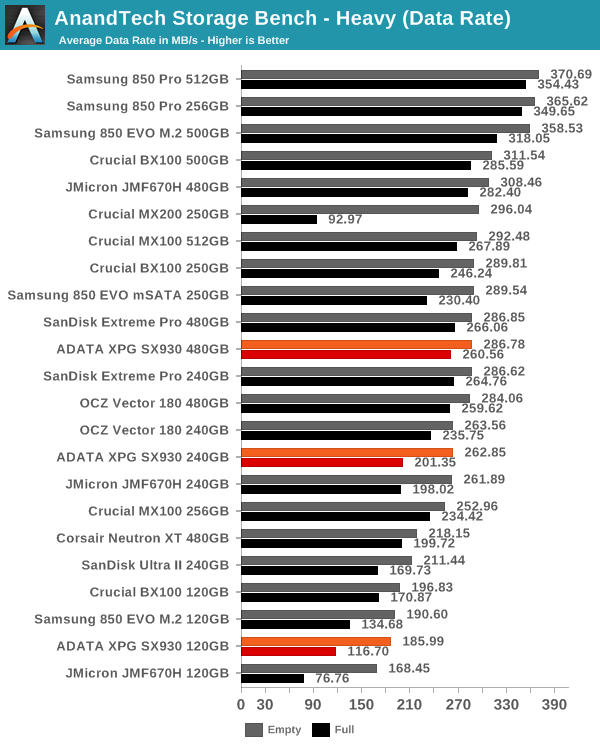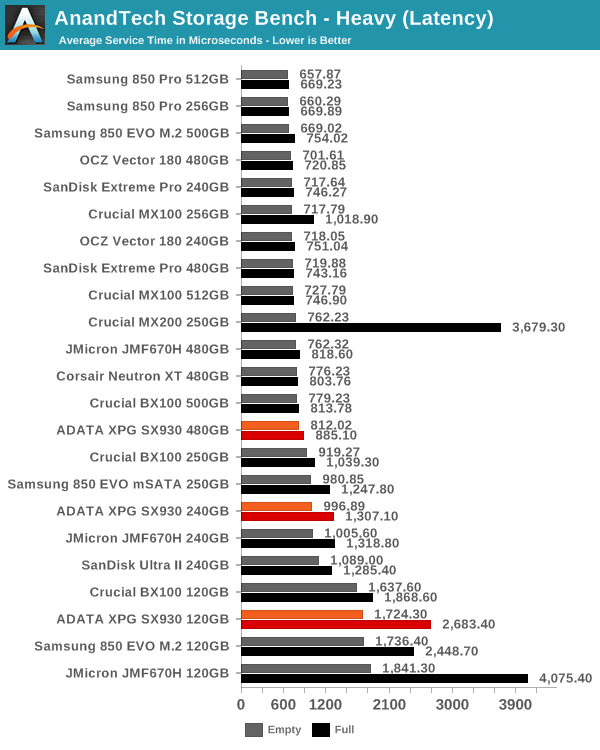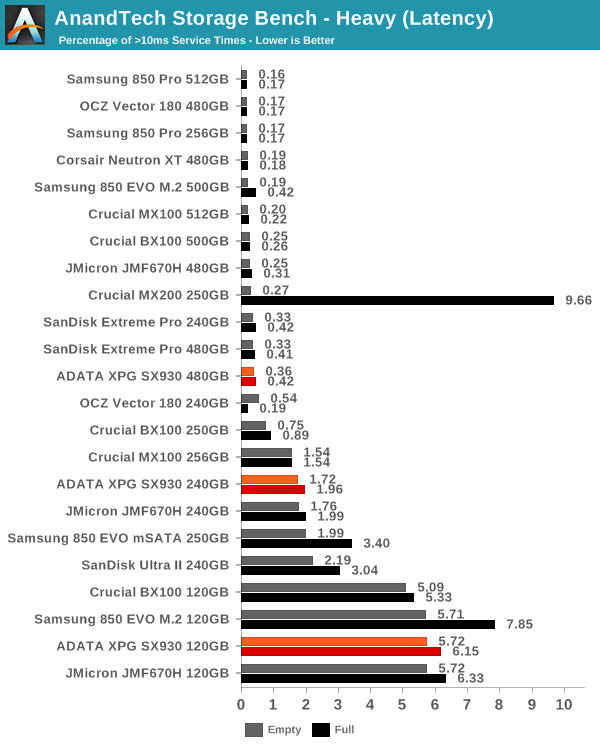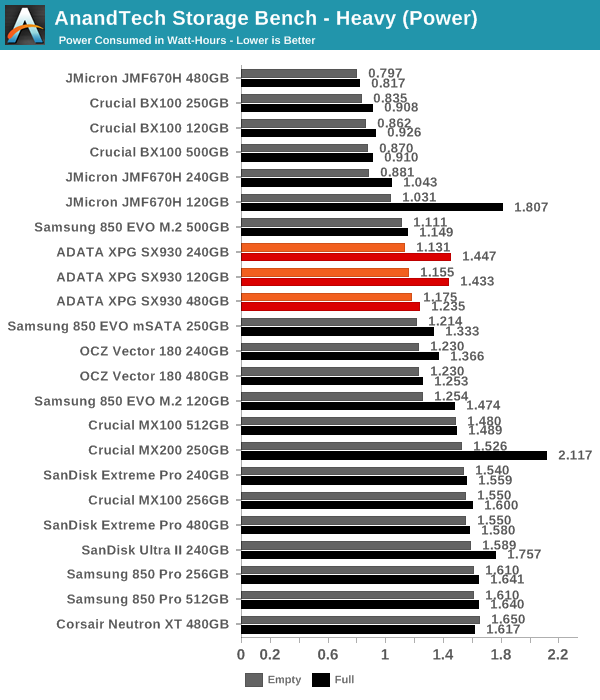ADATA XPG SX930 (120GB, 240GB & 480GB) SSD Review: JMicron JMF670H Debuts
by Kristian Vättö on July 16, 2015 10:00 AM ESTAnandTech Storage Bench - Heavy
While The Destroyer focuses on sustained and worst-case performance by hammering the drive with nearly 1TB worth of writes, the Heavy trace provides a more typical enthusiast and power user workload. By writing less to the drive, the Heavy trace doesn't drive the SSD into steady-state and thus the trace gives us a good idea of peak performance combined with some basic garbage collection routines. For full details of the test, please refer to the this article.

In our Heavy trace the SX930 is an average performer. To be frank, the JMF670H doesn't seem to have enough juice to go head to head with the 850 EVO and BX100, which is a shame because it leaves price as the only competitive advantage ADATA can have.

Surprisingly the 240GB model experiences more >10ms IOs in our Heavy trace than in The Destroyer. I would speculate this is due to the SLC cache filling up because the Heavy trace is more peak IO focused, whereas The Destroyer is built more for sustained performance, so it may be that in The Destroyer the controller just bypasses the SLC cache at some point and writes directly to MLC. In any case, optimizations are certainly needed to improve performance.

Power consumption, on the other hand, is relatively good. It's not BX100-level, but compared to some other high-end SSDs the SX930 has a more efficient power profile.











67 Comments
View All Comments
Impulses - Thursday, July 16, 2015 - link
The 500GB EVO has actually been $164 at Amazon for like a week, making it the cheapest one on the chart lol... Not sure why they list it at $178.The 1TB just went back down to $340 too... I want two in the long run, trying to decide whether to grab just one now and wait for better BF pricing or just grab both now.
MrSpadge - Thursday, July 16, 2015 - link
Yes, it's called the BX100. ARC100 is pretty decent, too.zodiacfml - Friday, July 17, 2015 - link
Nothing till other manufacturers release their 3D NAND versions. Don't forget about pricing too. ADATA couldn't compete because they don't design controllers or manufacture chips. They buy parts and assemble them, making it costly.Samus - Saturday, July 18, 2015 - link
Considering the MX100 is cheaper and more reliable with about the same performance, I think I just answered your question.Samsung TLC drives can not be trusted, specifically the 840 EVO and 850 EVO.
Flunk - Thursday, July 16, 2015 - link
When it comes to budget drives right now, if it's not cheaper than a Samsung 850 EVO I'm not even going to look twice. The EVO is much faster in most reasonable workloads than any of the other discount drives so I can't see paying more for less.MrSpadge - Thursday, July 16, 2015 - link
I don't see the EVO being "much faster" than a BX100 or ARC100. I'd rather say they're about on par.Uplink10 - Thursday, July 16, 2015 - link
"initial firmware mostly focused on optimizing performance for benchmarks such as CrystalDiskMark and AS-SSD, which typically use higher IO sizes and queue depths"I do not believe what am I reading. They are optimizing firmware so it will look good on charts but are not optimizing the firmware for all uses that the users will perform.
Components for a PC are used in a lot of ways and optimizing the component for just a few uses that are similar as known benchmark software is wrong. The way I see it they are trying to sell the drive by optimizing the performance that will look good in known benchmark software. That is wrong!!!
Kristian Vättö - Thursday, July 16, 2015 - link
It certainly is sad and unfortunately that is more or less the state of the whole component industry (smartphones having "Turbo" modes to exceed the TDP for improved benchmark scores). It's surprising how some SSD companies have very little understanding of real world client workloads and all they see is the few benchmark scores, which frankly are not even relevant to end-users.We are trying to fight the fight and convince manufacturers to focus on areas that matter. Getting JMicron to develop a new firmware just based on our feedback (they honestly had no idea why we are even testing low queue depth performance before I explained it to them) is a sign that companies value our input and expertise, which I think is ultimately a win-win for everyone.
Impulses - Thursday, July 16, 2015 - link
And we users thank ya for it. AT has been instrumental in providing valuable feedback to SSD manufacturers since the early days, regardless of who was doing the writing.Maybe it's time for Kristian's own "SSD Anthology"... :p Seems people keep asking everywhere whether M2/PCI-E or NVMe drives are worth it for them, I know the stock answer is "if you gotta ask..." but still.
Maybe a one time revisit of some real world testing? HDD vs SATA SSD vs etc one last time to reassess how far the gaps have grown and whatnot.
ggathagan - Thursday, July 16, 2015 - link
" (they honestly had no idea why we are even testing low queue depth performance before I explained it to them)"That's a scary confession. Makes you wonder if they should find another area of endeavor and leave this market to those who *do* understand.